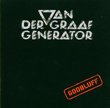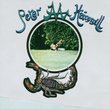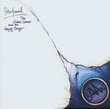| All Artists: Peter Hammill Title: In Camera (Mlps) Members Wishing: 2 Total Copies: 0 Label: EMI Japan Original Release Date: 1/1/2007 Re-Release Date: 1/8/2007 Album Type: Extra tracks, Import, Limited Edition, Original recording remastered Genres: Pop, Rock Styles: Progressive, Progressive Rock Number of Discs: 1 SwapaCD Credits: 1 |
Search - Peter Hammill :: In Camera (Mlps)
 | Peter Hammill In Camera (Mlps) Genres: Pop, Rock
|
Larger Image |
CD DetailsSimilar CDs
|
CD ReviewsDarkly profound lyrics but busy and jarring arrangements George L. Chadderdon III | Bloomington, IN, USA | 04/06/2008 (3 out of 5 stars) "3.5 stars. I have a great affinity for Peter Hammill's 1970's work--I've not yet heard enough of his later material--including his work with Van der Graaf Generator. There is a plaintive and ruminating seeking into the larger questions of existence and relationships which runs through the weighty, prolific volume of his lyrics. Among prog lyricists, he is the Bard of Introversion, has captured so well the world-view (and malaise) of the extremely reserved person struggling to connect with the world around them. ("House with No Door" and "A Plague of Lighthouse Keepers" come to mind.) As always, his lyrics on this album are poignant and profound, though sometimes they could be expressed more economically. "Ferret and Featherbird" seems to look wistfully and ruefully on a friendship that is drifting apart, but later notes ironically that the very distance seems to give an air of sanctity to the relationship. "(No More) the Submariner" (No More = Nemo?) looks back on a boy's childhood fantasies and compares them ambivalently with the realities of present life. "Tapeworm" is rather cryptic and diffuse in its imagery, but seems to express the sense of moving frantically, recklessly forward in life without having a clue where it will all lead. "Again" seems to be a reflection on a first sexual experience, unfortunately with someone who will not give that gift more than once. "Faint-heart and the Sermon" seems to be about the narrator listening to a sermon, being moved and wishing he could really believe, but ultimately being prevented by his rational skepticism. "The Comet, the Course, the Tail" is a mini-inquiry into free will which compares the sort of "free will" a man has in setting the course of his life to the wild (but resolutely determined) path traced by a comet. "Gog" is, as Peter phrases it in the liner notes, about "the God that just doesn't care", and has a kind of ecstatic darkness about it that is accented by the arrangement of the music. "Magog" is basically a kind of "dark ambient" [?] episode glorifying the brutal, inevitable law of entropy and decay which seems to lie in wait behind the mask of Gog. Three themes seem to dominate the album: the frustrating impermanence of relationships, lack of control or predictable direction in life, and the illusory nature of God. It is, among the albums I've heard so far, probably Peter's lyrically darkest. For all the lyrical depth of this album, however, it is marred, to my ears, by the choice of instruments and sounds, the arrangement, used in most of the songs ("Again", "Gog", and "Magog" seeming like exceptions.) (Note: some reviewers have complained about "Gog" and "Magog", but these tracks work for me, their arrangements underscoring the theme and mood of the lyrics.) There is a "busyness" and clutter to the arrangements of the harmonies that is distracting and sometimes cacophonious in songs that are actually musically quite coherent and interesting (as is apparent in the piano/voice versions heard in the extra tracks). Sometimes the effects processing muddies and obscures Peter's voice. There is a reaching here, a daring experimentalism in this album (as in a good deal of Peter's and VdGG's work) and some inventive musical ideas, but the many of the songs would strongly benefit by being rearranged so that their musical ideas stand out more clearly. This is nowhere better illustrated than on the last two bonus tracks which are piano and voice reductions of two of the tracks on the album. I find these more spare arrangements more satisfying because the harmony of the pieces in combination with the (sung) melody (which is what I mean by the "musical idea"), comes through more clearly and Peter's voice isn't so drowned out by effects and distracting instrumentation that detracts from much of the album." In Camera -- A Classic of the Progressive 70's Alfred Steffens Jr. | 03/25/2007 (5 out of 5 stars) "In Camera has always been my favorite Peter Hammill album. In fact, it has been one of my all time favorite albums. Peter Hammill is the lead singer in the group Van der Graaf Generator, a british rock group that peaked in the 70's and was considered to be in the same genre as King Crimson and Genesis (of the Peter Gabriel era). What separated Van der Graaf from the other groups in this genre was Peter Hammill's distinctive vocals. Van der Graaf, like the other british "prog" groups of this era like Yes and Genesis, began with a style that developed from 60's pop rock. The early 70's saw these groups gradually evolving into a new genre. Indeed, by 1974 all the groups in this genre were breaking new ground and beginning to define new styles of musical expression that resulted in a high water mark yet to be exceeded. These groups were playing there instruments with more expression, and writing material with more instrumental depth and compositional devices such as key, tempo and dynamics changes. Van der Graaf Generator was a principle example of such a group. Their classic 70's album, Pawn Hearts, sounds drastically different from, and more advanced than, their 60s-rock album Aerosol Grey Machine. In the case of Van der Graaf Generator, the evolution of their music was most prominent in Hammill's vocals. The singing on their first album, Aerosol Grey Machine, had been soft, melodic and generally beautiful. With each successive album Hammill's vocals were increasing in expressiveness. By the album Pawn Hearts, Hammill had a unique, if not definitive, vocal style that ranged in form from a delicate falssetto to a loud, bloodshot-eyes, in-your-face kind of singing. Peter Hammill's style was more than just different. It was impressive. In 1974, as a 19 year-old kid, I was "initiated" into Van der Graaf by a couple of musician friends who dragged me into a room having one wall lined with a professional PA system through which the Van der Graaf album Pawn Hearts was played in its entirety at 140 decibels. I had heard absolutely nothing like Van der Graaf Generator before this time. As well as being a defining moment in my musical evolution, this listening event set my impressions of Peter Hammill. The lyrics were of a serious, intelligent, educated level that is never found in popular music. And of the vocal style, my impression of Hammill was that of the angry english poet--a Hamlet-like persona that I could easily envisage ranting from the parapet of a castle wall or as a wandering bard from out of the forest. Thereafter I searched in vain for Van der Graaf Generator in the record stores. At last, I found a small shop that imported records from Europe, and he had Van der Graaf albums. That day I bought two records: Pawn Hearts and the then latest Peter Hammill album called In Camera. I asked the record store owner why they didn't sell Peter Hammill records in the other stores. He raised his eyebrows and laughed, saying, "because he's too heavy for 'em." And so he was. I was the first among friends to have this album, and I played it to people whenever I could and noted their opinions. Among my musician circle the response was overwhelmingly positive. One of my friends who had heard Hammill's earlier solo albums remarked that In Camera was nearly as heavy as Pawn Hearts. There was critiquing of the overall production. It was clear that Hammill had played most of the instrumental tracks by overdubbing them on a tape machine. In places the instruments were off sync--finessed quite artistically on Ferret and Featherbird but more obvious in other places. But there was a consensus on the high-point of the album: Gog (and Magog). We were speechless. We shook our heads in amazement. I recently bought the CD, now that it can be easily obtained thanks to our internet age. I was at first apprehensive that, hearing it again after all these years, I might not hear the same magic as I did when I was a nineteen year-old. I wasn't disappointed. It doesn't sound dated, because Peter Hammill's music was never part of a popular trend. Each of these songs, which I have literally heard hundreds of times, sounded as powerful as ever. This is owing to the expressiveness of Hammill's singing. I still got chills up and down my spine listening to Gog and Magog. The bonus tracks are excellent. I like all of Peter Hammill's solo albums, but In Camera is my favorite. In Camera is where Hammill went that noone else could ever follow. As for the cloak--he fits the part quite well. Listen to the record." One of Hammill's finest solo albums BENJAMIN MILER | Veneta, Oregon | 04/10/2007 (5 out of 5 stars) "During the period of VdGG's 1972-1975 hiatus, Peter Hammill gave use four solo albums, many of them with help from various VdGG members, Chameleon in the Shadow of the Night (1973), The Silent Corner and The Empty Stage (1974), and Nadir's Big Chance (1975). Of course sandwiched between The Silent Corner and Nadir's is In Camera, released in 1974.
This album featured Chris Judge Smith and Guy Evans (both ex-VdGG), plus Paul Whitehead (album cover artist best known for the Genesis and VdGG album covers), and David Hentschel (Trident Studio engineer, future Genesis producer and the guy who played the monster ARP 2500 synthesizer on Elton John's "Funeral For a Friend"). It needs to be said that Paul Whitehead was unaware he participated on the album, and was more likely Hammill borrowed some tracks from him, after all it was by this time that Whitehead had left the U.K. for the U.S. (he preferred the sunnier skies of L.A. to that of London) (this explained why Foxtrot was the last Genesis album to feature his artwork). This is less a VdGG album than Hammill's predecessor, The Silent Corner, simply because you don't have Hugh Banton's organ or David Jackson's sax and flute. Instead you have Peter Hammill handling all vocal, guitar, piano, Mellotron, and harmonium, with David Hentschel providing the ARP synth programming, and the rest of the guys playing drums on various tracks. I suspect the ARP synth being used is indeed the ARP 2500, as many of the synth passages sound too elaborate for the smaller, more user-friendly ARP 2600 to do, not to mention it was David Hentschel who used that beast on Elton John's "Funeral For a Friend". It was Peter who played the ARP, but since he never used one on any of his solo other albums, I can fairly feel safe that he was using David Hentschel's ARP 2500 (VdGG did use an ARP on Pawn Hearts, but I'm sure that was simply an ARP 2600 owned or borrowed by the band). "Ferret & Featherbird" is a mellow opening piece, dominated by acoustic guitar, with a slight country feel. It's one of those pieces Hammill written back in the late '60s, but never got to recording it on album until now. It wouldn't seem out of place on The Aerosol Grey Machine. "(No More) the Sub-Mariner" is a much more sinister piece done in Hammill's dramatic fashion, with layers of ARP on top of it (including some wonderful pulsing effects). "Tapeworm" is a much more rock-oriented piece with drums. I really love the intensity of this piece, then out of nowhere, Hammill pulls a Gentle Giant by including a bunch of GG-like vocal harmonies, before rocking again like most of the rest of the song. "Again" is a nice, gentle acoustic ballad that leads up to "Faint-Heart & the Sermon". A great epic full of majestic Mellotron passages and more of use of the ARP, with some strange electronic effects as well as more conventional synth sounds. "The Comet, the Course, the Tail" is an interesting, but short piece that alternates between more mellow and acoustic, and more rocking passages. Then comes the ever sinister "Gog" that's so mindblowing you gotta hear it to believe it! Lots of intensity and some jazzy drumming, plus that harmonium. But then this album has that similar problem to King Crimson's In the Court of the Crimson King (second half of "Moonchild") or Can's Tago Mago ("Aumgn" and "Peking O"), a such off-the-wall experiment that many people can live without. I'm referring to "Magog (In Bromine Chambers)". Many people would obviously write this off as "self-indulgent noise", and true, a better portion of this piece is full of distortion and feedback, but I really love the sinister atmosphere, and I often like off-the-wall stuff (that's why I have no problem going through "Aumgn" and "Peking O" when listening to Tago Mago). This is so out-there that it would be totally out of the question on any given VdGG album, or even Hammill's other solo albums. And even if you couldn't stand "Magog", it's hard denying that the rest of the album is so good, you can forgive the noise that ends the album. I have to admit the album cover is utterly ridiculous, Peter Hammill himself wearing a cape to give him that melodramatic look (to emphasize the melodrama that's so dominate in a lot of his music, both solo and with VdGG). Honestly I can live without the cover. Even with "Magog (In Bromine-Chambers)", I really feel that In Camera is simply one of the greatest progressive rock albums ever made, right there with VdGG's H to He and Pawn Hearts, not to mention Hammill's previous offering, The Silent Corner and the Empty Stage. It's that great!" |

 Track Listings (11) - Disc #1
Track Listings (11) - Disc #1

